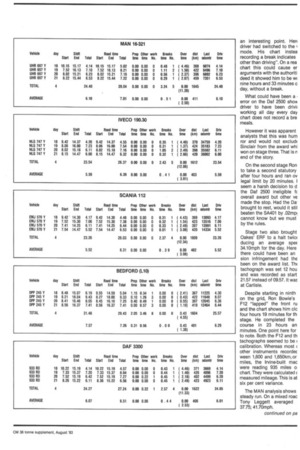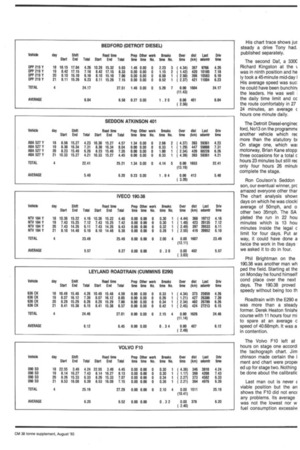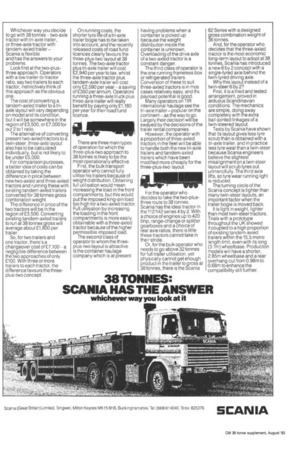What the tachos sa
Page 51

Page 53

Page 55

Page 56

If you've noticed an error in this article please click here to report it so we can fix it.
THE 38-TONNE run was E qualified success but was on men and machines.
When it was all over th team got down to compilir provisional results. We str they were provisional be each day's tachograph cha to be analysed by Lucas-K Management Analysis.
We made the point strong it is as well we did so. Whc charts were analysed there dramatic change in the sional score sheet.
The Daf 2500 had been is the stage 3 provisional winni also the overall winner, b( the Seddon Atkinson 4C .02mpg or 34.2 yards per gal 1.5 litres per 100km. Sad to s. driver had breached the ri tions on stage 2 and by our the vehicle's performance fc day was null and void. It cou therefor be considered to overall winner award.
The chart analysis shows c that the 1,000 miles cou covered inside 30 hours c over a variety of roads and • conditions.
The fastest time overall recorded by the Volvo Fl which Ron Bowie aver 42.90mph. The analysis shay, longest recorded time was ed on the Daf 2500 driven tr Sinclair with 26 hours 32 mi but the reason for that bec obvious later.
The Bedford L10 returne lowest average at 38.77mph can be compared with the Be E290 at 40.26mph and the C Diesel at 41.24mph.
On the second stage the ford E290 made two stal stops totalling one hour and minutes, but still complete, 265 miles in seven hours al minutes. Stuart Nancollis' F NTE350 was stopped twic stages three and four but wa: inside the legal time limit E end of each stage.
The lveco 190/30 also hac stops on the Bothwell to She leg to keep Ian Metcalfe with' drivers' hours regulations.
The Bedford L10 had breaks on stages two and fc This chart analysis throvs
an interesting point. Hen driver had switched to the N mode. His chart instea recording a break indicates other than driving". On a rea chart this could cause er arguments with the authoriti deed it showed him to be w( nine hours and 33 minutes c day, without a break.
What could have been a error on the Daf 2500 shovs driver to have been drivii working all day every day chart does not record a bre meals.
However it was apparent analysts that this was hum ror and would not exclud( Sinclair from the award whi won on stage three. That is n end of the story.
On the second stage Ron to take a second statutory after four hours and ran ov legal limit by 20 minutes. I seem a harsh decision to d the Daf 2500 ineligible fc overall award but other ve made the stop. Had the Da. brought to rest, would it stil beaten the SA401 by .02mpi cannot know but we must by the rules.
Stage two also brought Oakes' ERF to a halt twic( ducing an average spec 34.10mph for the day. Here there could have been an sion infringement had the been on the award list. ThE tachograph was set 12 hou and was recorded as start 21.57 instead of 09.57. It wa.F. at Carlisle.
Despite starting in ninth on the grid, Ron Bowie's F12 "lapped" the front ru and the chart shows him cic four hours 19 minutes for th stage. He completed the course in 23 hours an minutes. One point here for to note. Both the F12 and th tachographs seemed to be ( calibration. Whereas most t other instruments recordec ween 1,600 and 1,650km,or miles, the Irvine-built mac were reading 935 miles oi chart. They were calculated ( measured mileage. This is at six per cent variance.
The MAN analysis shows steady run. On a mixed roac Tony Leggett averaged 37.75; 41.70mph.
His chart trace shows jUE steady a drive Tony had. published separately.
The second Daf, a 330C Richard Kingston at the was in ninth position and he ly took a 45-minute mid-day I His average speed was sucl he could have been bunchini the leaders. He was well i the daily time limit and cc the route comfortably in 27 24 minutes, an average c hours one minute daily.
The Detroit Diesel-enginec ford, No13 on the programmE another vehicle which rec more than the statutory br On stage one, which we; motorway, Brian Kane stoop three occasions for a total c hours 23 minutes but still rec only four hours 26 minuti complete the stage.
Ron Coulson's Seddon son, our eventual winner, prc amazed everyone other thar The chart analysis show5 days on which he was clocki average of 50mph, and o other two 35mph. The SA pleted the run in 22 hou minutes which is 13 hou minutes inside the legal c limit for four days. Put ar way, it could have done a twice the work in five days• we asked it to do in four.
Phil Brightman on the 190.38 was another man wh ped the field. Starting at the on Monday he found himself cond place over the next days. The 190.38 proved speedy without being too th Roadtrain with the E290 e was more than a steady former. Derek Heaton finishE course with 11 hours four mi to spare at an average c speed of 40.68mph. It was a in contention.
The Volvo F10 left at hours on stage one accordi the tachograph chart. Jim chinson made certain the i rnent and chart were proper ed up for stage two. Nothing be done about the calibratic Last man out is never z viable position but the an shows the F10 did not encc any problems. Its average was not the lowest nor w fuel consumption excessiw Whichever way you decide to go with 38 tonnes two-axle tractor with tri-axle trailer, or three-axle tractor with tandem-axled trailer Scania is flexible and has the answers to your problems.
Look first at the two-plusthree approach. Operators with a low trailer-to-tractor ratio, say two trailers to each tractor, instinctively think of this approach as the obvious one.
The cost of converting a tandem-axled trailer to a triaxle layout will vary depending on model and its condition, but it will be somewhere in the region of £3,500, or £7,000 for our 2 to 1 ratio.
The alternative of converting present two-axled tractors to a twin-steer, three-axle layout also has to be calculated individually, but is not likely to be under £5,000.
For comparison purposes, a better idea of costs can be obtained by taking the difference in price between new two-axled and three-axled tractors and running these with existing tandem-axled trailers converted for 38 tonnes gross combination weight. The difference in price of the two tractors will be in the region of £3,500. Converting existing tandem-axled trailers to run at 38 tonnes gross will average about £1,800 per trailer.
So, for two trailers and one tractor, there's a changeover cost of £7,100 —a negligible difference between the two approaches of only £100. With three or more trailers to each tractor, the difference favours the threeplus-two concept. On running costs, the shorter tyre life of a tri-axle trailer bogie has to be taken into account, and the recently released costs of road fund licences clearly favours the three-plus-two layout at 38 tonnes. The two-axle tractor plus tri-axle trailer will cost £2,940 per year to tax, whilst the three-axle tractor plus tandem-axle trailer will cost only £2,590 per year a saving of £350 per annum. Operators running a three-axle truck plus three-axle trailer will really benefit by paying only £1,180 per year for their road fund licence.
There are three main types of operation for which the three-plus-two approach to 38 tonnes is likely to be the most operationally effective.
First, the bulk transport operator who cannot fully utilise his trailers because of weight distribution. Obtaining full utilisation would mean increasing the load in the front compartments, but this would put the imposed king-pin load too high for a two-axled tractor. Full utilisation by increasing the loading in the front compartments is more easily obtainable with a three-axled tractor because of the higher permissible imposed load.
The second class of operator to whom the threeplus-two layout is attractive is the container haulage company which is at present having problems when a container is picked up because the weight distribution inside the container is unknown. Overldading of the drive axle of a two-axled tractor is a constant danger. The third class of operator is the one running frameless box or refrigerated trailers. Conversion of these to suit three-axled tractors is in mos cases relatively easy, and the payload potential is good. Many operators on TIR international haulage see the tri-axle trailer—popular on the continent— as the way to go. Largely their decision will be swayed by the decisions of the trailer rental companies. However, the operator with a proportion of three-axled tractors in the fleet will be able to handle both the new tri-axle trailers and tandem-axied trailers which have been modified more cheaply for the three-plus-two layout.
For the operator who decides to take the two-plusthree route to 38 tonnes, Scania has the ideal tractor in the 112/142 series 4 by 2. Wlth a choice of engines up to 420 bhp, range-change or splitter gearboxes and a choice of rear axle ratios, there is little these tractors cannot take in their stride.
Or, for the bulk operator who needs to go above 32 tonnes for full trailer utilisation, yet physically cannot get enough product in the trailer to gross at 38 tonnes, there is the Scania 82 Series with a designed gross combination weight of 36 tonnes.
And, for the operator who decides that the three-axled tractor is the most economic long-term layout to adopt at 38 tonnes, Scania has introduced a new 6 by 2 concept with a sing le-tyred axle behind the twin-tyreci driving axle. Why this layout instead of a twin-steer 6 by 2?
First, it is a tried and tested arrangement, proved in arduous Scandinavian conditions. The mechanics are simple, doing away completely with the extra ball-jointed linkages of a twin-steered layout.
Tests by Scania have shown that its layout gives less tyre scrub than is obtained with a tri-axle trailer, and in practice less tyre wear than a twin-steer because Scania engineers believe the slightest misalignment on a twin steer layout will scrub tyres out unmercifully. The third axle lifts, so tyre wear running light is reduced.
The turning circle of the Scania concept is tighter than many twin-steer layouts, an important factor when the trailer bogie is moved back.
It is light in weight, lighter than most twin-steer tractors. Trials with a prototype throughout the UK showed it coupled to a high proportion of existing tandem-axled trailers within the 15.5 metre length limit, even with its long (3.1m) wheelbase. Production models will have a shorter, 2.85m wheelbase and a rear overhang cut from 0.98m to 0.68m to enhance the compatibility still further.




























































































































